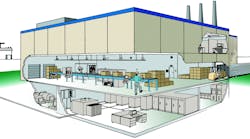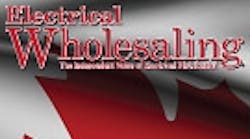As the electrical market has become more global on scope, it's important to look beyond our traditional borders and understand the larger picture. Electrical Wholesaling asked our friends in Canada to give us an overview of the most significant differences and the most remarkable similarities between the U.S. and Canadian electrical worlds.
In the Second World War, George Patton was addressing a group of English church goers and gave them a quote from George Bernard Shaw: “I believe that the British and the Americans are two peoples, separated by a common language.”
This could be said of the United States and Canada as well.
Canada — an overview
Some interesting differences between the two countries will provide a bit of insight. Like the United States, Canada enjoyed a robust manufacturing climate for many years, and electrical equipment manufacturing was a vital category. Domestic electrical manufacturers like MARR Connectors (now part of Thomas & Betts Canada) and Temco (now part of Hubbell Canada) grew up in Canada and established such successful beachheads that they were acquired by larger companies seeking strategic leverage to gain a deeper rapport with the channel. Meanwhile, companies such as Hammond Power Solutions have grown beyond Canada to be active in the U.S. electrical equipment channel. There is no question that in the early days before NAFTA many U.S.-based companies such as Triangle Conduit and Cable found easier access to the Canadian market by being here with a manufacturing facility. Southwire did this recently, too.
The history of electrical equipment manufacturing has been a wonderful part of the fabric of both countries. Many manufacturers present in both countries — Ideal Industries, Panduit, Legrand and others — have proven the theory that being local is important in Canada.
The exchange of talent flows both ways across Canada's southern border. Many Canadians have done well in the electrical manufacturing and distribution space in the United States and have been appointed to some of the highest posts in the market. Dick Waterman worked his way up through the distribution ranks in western Canada before becoming CEO of Rexel USA and Neil Parker held a number of senior executive posts in Canada before becoming president of T&B's electrical division back in the 1990s.
History and names all play a role, but clearly in the Canadian market company names hold a ton of goodwill as evidenced by Rexel continuing to name its acquired Ruddy electric branches Westburne Ruddy years after the family stopped being involved in the day-to-day operations.
The channel has a huge history with family names like Smith, Gerrie, Macdonald, Horsman, McLoughlan, Boileau, Backman and Shapiro running family enterprises that go back in some cases to the early 1900s.
As in the United States, consolidation has been a part of the story of Canadian electrical distribution, as larger independent distributors have over time acquired one another or sold to multi-nationals like Sonepar and Rexel. Local independents also are actively increasing their footprints as evidenced by Burlington Ontario's recent moves to acquire Sonepar's Trade Electric and an independent, TESCO.
Canada's market size and orientation geographically caused it to build its electrical wholesaling base on a somewhat different foundation than the U.S. National wholesalers became part of the industry quickly with the formation of Northern Electric (now NEDCO, part of Rexel), Zenith (also part of Rexel) and WESCO, which established its business in the Canadian market by selling a basket of electrical equipment built in plants in eastern Canada. The acquisition of Westburne/NEDCO by Rexel in 1979 laid the foundation for further acquisitions by nationals, despite the influence of well-established national marketing groups like Spancan and Copel (which merged with Affiliated Distributors in 1993), which attempted to give smaller independent distributors comparable purchasing power as the nationals with volume-purchasing agreements. Sonepar established itself in Canada before entering the U.S. market through its acquisitions of Lumen Pointe-Claire, Quebec, its first Canadian purchase in 1984; Gescan, Milton, Ontario, in 1989; Texcan, Vancouver, British Columbia, in 2001; and Osso Electric, Oshawa, Ontario in 2007.
The early days in Canada's consolidation brought growing pains as manufacturers wrestled with closing local warehouses as their distributor partners grew more sophisticated. On the manufacturing side, most of the global players are all in Canada, including Rockwell, Eaton, Phillips, Southwire, General Cable, Panduit, Hubbell, Legrand and EGS. Many of these manufacturers were attracted by a need to supply the oil patch, utility expansions or automotive production. Many have adapted to the Canadian market by building and designing unique Canadian-only products to address hazardous environments and other client concerns.
Moving forward, unlike the United States, Canada will be treading lightly on consolidation in both the channel and manufacturing, held back by the simple fact there is only so much share left. Deals will still be done, as Canada still boasts many family-owned enterprises that have no succession plans in place.
Overall size
Canada has fewer branches run by full-line electrical distributors than the U.S. — an estimated 787 in Canada, compared to 7,100 in the U.S. The total market as defined by sales from the electrical distributor to the end user is smaller: Canadian sales were CAN$7.8 billion (US$6.53 billion) in 2008, compared to US$85 billion in the United States. For years the Canadian market was always looked at as 1/10 of the U.S. market, but clearly that does not apply anymore in terms of dollars, and the comparison hides subtle differences. Many electrical products sold to the OEM sector in the United States end up in Canada, and as such represent only a future MRO opportunity. Electrical wholesalers' product mixes also differ. For instance, electric heating systems are more common in electrical distributors' inventories in Canada than in most regions of the United States.
Market structure
When you look at the top five distributors in each market, a key difference becomes clear. In the United States, the five largest companies represent 18 percent to 21 percent of the total market. In contrast, the five largest electrical distributors in Canada represent more than 65 percent of total industry sales. National distribution, like national banking, has won the day in Canada, even though many of the same national distributors are located in both countries.
Until recent economic times, the Canadian market has been dominated by Ontario. This province, which used to drive more than 40 percent of the electrical spending in the country, is suffering from the same automotive-related ills as Michigan and Ohio. It used to be said that Ontario drove the Canadian economy. That's no longer the case, as Alberta and British Columbia have combined to take the lead. Interestingly, the also-ran Atlantic provinces have done a great job holding up the electrical market with their combined major projects hitting the order books in the first quarter of 2009.
Many also tend to overlook the dynamic role of Quebec in Canada's electrical market — a factor that did not escape many international electrical equipment companies who established facilities there before coming to the United States. Siemens and Klockner-Moeller, for example, wanted to capitalize on the growing expenditures in electrical generation projects that made Quebec an early adopter of the emerging control technologies. Others followed, but it's interesting to note Canada's electrical market has always had a huge Quebec-based influence in the channel and in manufacturing probably more so than any other region in North America.
Simply put though, four provinces — Ontario, Quebec, British Columbia and Alberta — control almost 80 percent of the total market. The United States' diversity, along with its huge population centers, drive sales in the MRO space at a volume that Canada can't for the most part match.
Marketing groups
Marketing groups have been part of the fabric of the Canadian electrical industry for years and will be part for years to come, though one might think the dominance of the nationals in Canada would deny marketing groups the foothold they have established. In fact, the total sales of the members of the major marketing groups in Canada — Affiliated Distributors (A-D) and Independent Electrical Distributors (IED) — represent between 23 percent and 26 percent of total electrical sales in Canada. Looking at the two major marketing groups in the United States (A-D and IMARK), we see the exact same share range.
When we called electrical manufacturers that sell their products in both countries and discussed sales forces, we did find common ground. Depending on the manufacturers, the use of direct sales forces and the use of independent manufacturers' representatives were found in both countries. Both countries have associations for agents, NEMRA - National Electrical Manufacturer Representatives Association, in the United States and CEMRA - Canadian Electrical Manufacturer Representatives Association in Canada. In Canada, there are estimated to be 45 to 65 agencies, while there are 475 electrical agencies in the United States. Agencies have a much larger share of the electrical equipment sales coming in at 65 percent of the total electrical product sales in the United States while in Canada it's closer to 40 percent of the total sales primarily because Canada's major trading areas of economic activity are so concentrated.
North American Free Trade implications
The United States implemented NAFTA packaging guidelines more than 10 years ago. One of the guidelines covers instruction sheets and labeling requirements. Put simply, the use of English, Spanish and French should appear on all instruction sheets and label descriptions of the product. While Quebec requires unique labeling, many manufacturers and distributors alike have come together to address this unique requirement.
Currencies, taxes and standards
Another obvious difference between the two markets is the lack of a common currency. Like most trading partners globally, the U.S. dollar is the de facto benchmark, but understanding what drives the relative exchange rates is critical to ongoing success and margin protection. When the price of oil is high, Canadian dollars rise. When car sales slump the effect crosses borders to both countries. So keep in mind that if you want to sell your products in either country, you must have the ability to sell and bill in local currency and understand its resulting effects.
Taxation rules and regulations are different and this alone can be troublesome for manufacturer/distributor relationships. State and federal taxes run parallel in concept to Canada's provincial and federal GST taxes. This is not a huge hurdle, but to avoid confusion and unexpected delay in selling product you need to remember the impact that the differences in currencies and taxes have on selling products in Canada.
We have found that regulatory bodies in Canada and the United States, (CSA - Canadian Standard Association and UL - Underwriters' Laboratories), have made great strides in the harmonization of codes and testing requirements. Manufacturers located in both countries have recognized this issue and have been working together to achieve a smooth transition between these two most important agencies.
Underlying differences in cultural approaches abound
Cultural differences between Canada and the United States can cause further confusion. Selling cycles in Canada are longer and “getting to know you better” is more a mantra than price. Relationships drive the business and partnerships north of the U.S./Canada border.
The role of the electrical distributor is basically the same everywhere in the world. With hands-on experience selling electrical equipment in 60-plus countries, we can attest to the standard business model where a distributor will carry local inventory, multiply the manufacturer marketing efforts, and provide credit to the ultimate end user. There are no differences on these common roles. However, our manufacturer survey respondents, backed up by our personal experiences, do indicate that there seem to be closer working relationships between distributors and manufacturers in Canada. While our survey did not go into detail on this, it's important to recognize right from the start.
Listed in the chart on page 25 are the areas that are the same in Canada and the United States concerning the electrical channel of distribution.
Partnership opportunities abound
The opportunities presented by specialty distribution abound in Canada as well as the opportunity to work across borders. Here are some recommendations for companies that want to expand their businesses in Canada.
-
Demonstrate Canadian content in products.
-
Sell and bill orders in Canadian dollars.
-
Be aware of cultural differences — Canada is a different country — and the need to respect other ways of doing business.
-
Just because something is standard in the United States, do not assume this is the correct way or is looked at in the same way in Canada.
The survey confirmed the theory that economically we are continuing to conduct business in both countries while we are moving towards a borderless community. Yes, we will always have a border, politics and someone who wants to play by their own rules, but we did find a history, and opportunity for all to grow.
Paul Eitmant and John Kerr Jr. first met in Canada in 1980. Together they have built IP Group International into a consultancy practice with offices in Chicago, Scottsdale, Toronto, Taipei and Geneva. They have authored numerous and specialized research documenting the electrical market globally. You can Paul Eitmant by phone at (480) 488-5646 or by e-mail at [email protected]. Contact John Kerr by phone at (705) 527-7677 or by e-mail at [email protected]. The company's website is www.ipgroupinternational.com.
Comparing the U.S. and Canadian Markets
Take a line of credit from ultimate end user
Enhance manufacturers' marketing efforts at a local level
Take a line of credit from ultimate end user
Enhance manufacturers' marketing efforts at a local level
A Note From the Authors
In writing any article on the subject matter you have been living with for over 35 years, your first mental response is, “No problem, this won't be that difficult.” While a historical perspective is important, living today's issues is a must. In attempting to rise to the challenge of writing on the differences between Canada and the United States our team sought out the help of a bunch of individuals that have lived both in Canada and the United States and/or have had responsibility for their respective divisions located in both countries. Thanks must go to all these individuals who took the time to help us with their perspectives and share their opinions as leaders of the electrical industries in both Canada and United States. — Paul Eitmant and John Kerr










